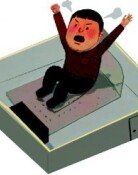Lets Learn from Gumi Where Annual Exports Approach $30 Billion
Lets Learn from Gumi Where Annual Exports Approach $30 Billion
Posted October. 18, 2005 06:51,
Visiting the fourth industrial complex in Gumi, Gyeongbuk Province, on October 7, diplomats and business leaders from 10 countries were astonished throughout their tour. Among the visitors were a commercial attaché of the Belgium Embassy to Korea who participated in the tour with the support of the European Union Chamber of Commerce in Korea (EUCCK) and the CEO of Siemens.
It is rare to see in this world such a small city posting almost $30 billion of annual exports.
It is surprising that most of the companies in the industrial park are in state-of-the-art industries, such as telecommunications.
Gumi has had steady visits by prominent overseas figures from politics and business. Stephen Bosworth, former U.S. ambassador to Korea, and Toshiyuki Takano, former Japanese ambassador to Korea, visited the city during their terms in Korea.
Japanese economic leaders also pay frequent visits to the city, including Hiroyuki Ishige, director-general of the Manufacturing Industries Bureau; Sadayuki Sakakibara, president of Toray; and Takashi Wada, president of Display Company division of Asahi Glass.
They came to Gumi even without an invitation from the city. Their visits aimed at discussing substantial methods of economic cooperation rather than a formal photo-op.
Rene Francisco Umana, Honduran ambassador to Korea, visited the citys industrial complex in May and proposed economic cooperation. He said, A country of seven million in Central America, Honduras sets a small but rich city, like Gumi, as its model, adding, I want to study how you made such an achievement.
Radinck J. van Vollenhoven, Netherlands ambassador to Korea, visits Gumi every year to find ways to help Philips which made a joint venture with LG. The ambassador and his wife became an honorary citizen of the city.
Eindhoven, a proud industrial city of the Netherlands, set up a sisterhood relationship only with Gumi and Nanjing, China in Asia.
The reason why overseas figures are paying attention to Gumi is the citys remarkable exports. Created in the early 1970s, the Gumi Industrial Complex is expected to post $30 billion in exports almost 30 years after hitting the $100 million mark. The city exports four times as much as Busan and represents 70 percent of domestic trade balance last year.
As the city grows with increasing exports, the population of the city has also grown by some 7,000 annually. The citys population is now 370,000 compared to 330,000 in 2000. About 5,000 among them are foreigners.
Jang Byung-tae (45) who had used to commute from Daegu moved to the city with his family last year.
He said, I decided to settle down in Gumi as it is a cozy city with a high income level and good educational environment, adding, Im satisfied because I feel it is an international city.
Gumi started economic cooperation with San Jose in Silicon Valley last year. San Jose, in which 920,000 people live, exports $2.8 billion annually.
San Jose Mayor Ron Gonzales said, As equal export cities, San Jose and Gumi can cooperate economically, to Gumi city officials who visited the U.S. city last year.
The Gumi city authorities proposed that they would hold a Trade Day ceremony for the first time as a provincial city. The event is currently scheduled for Seoul in late November.
Gumi Mayor Kim Kwan-yong said, A small city that accounts for 0.7 percent of the population represents 12 percent of national exports, adding, I hope that Gumi will hold this years Trade Day ceremony to achieve the goal of exporting $50 billion by 2007.
Kwon-Hyo Lee boriam@donga.com







